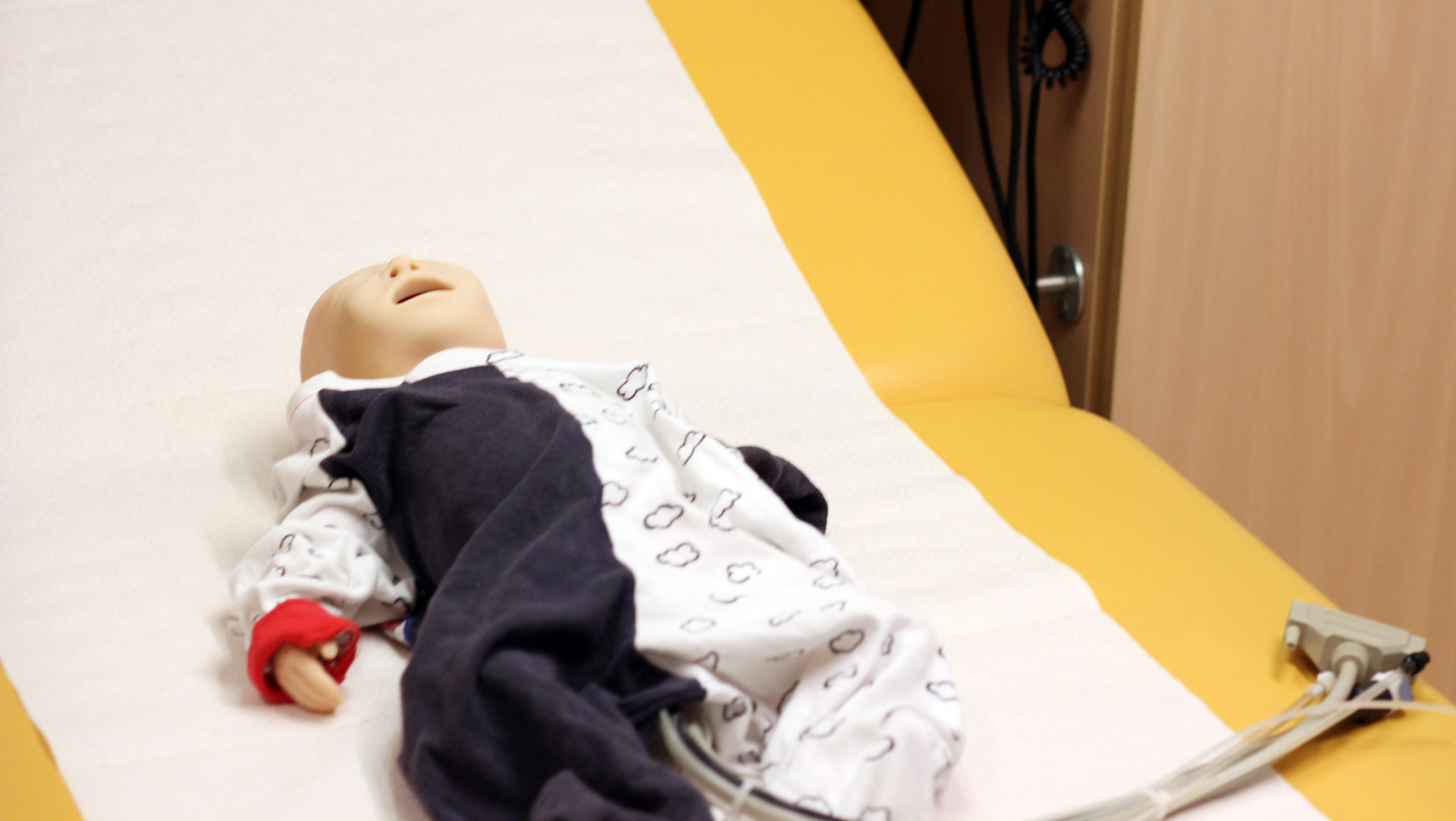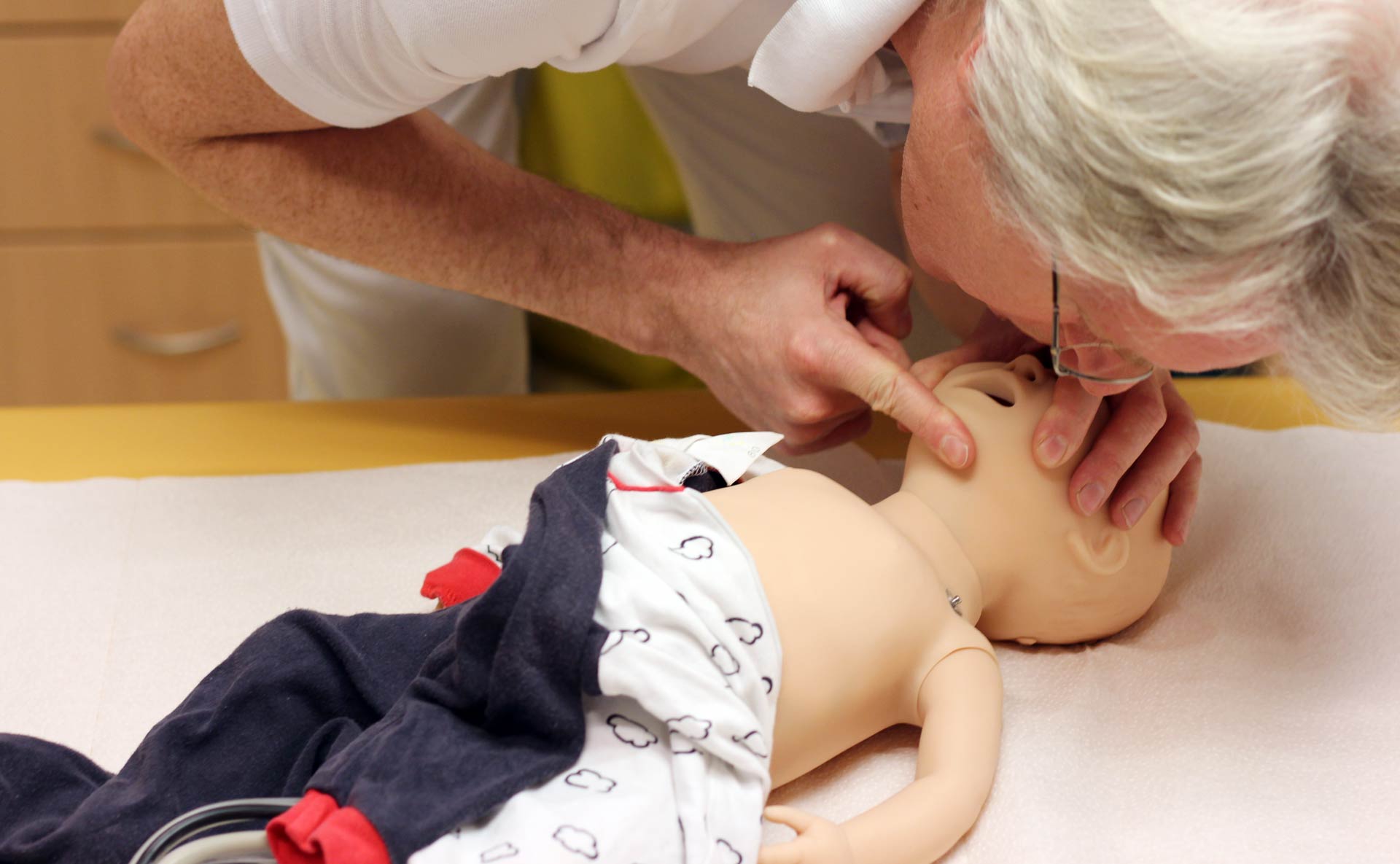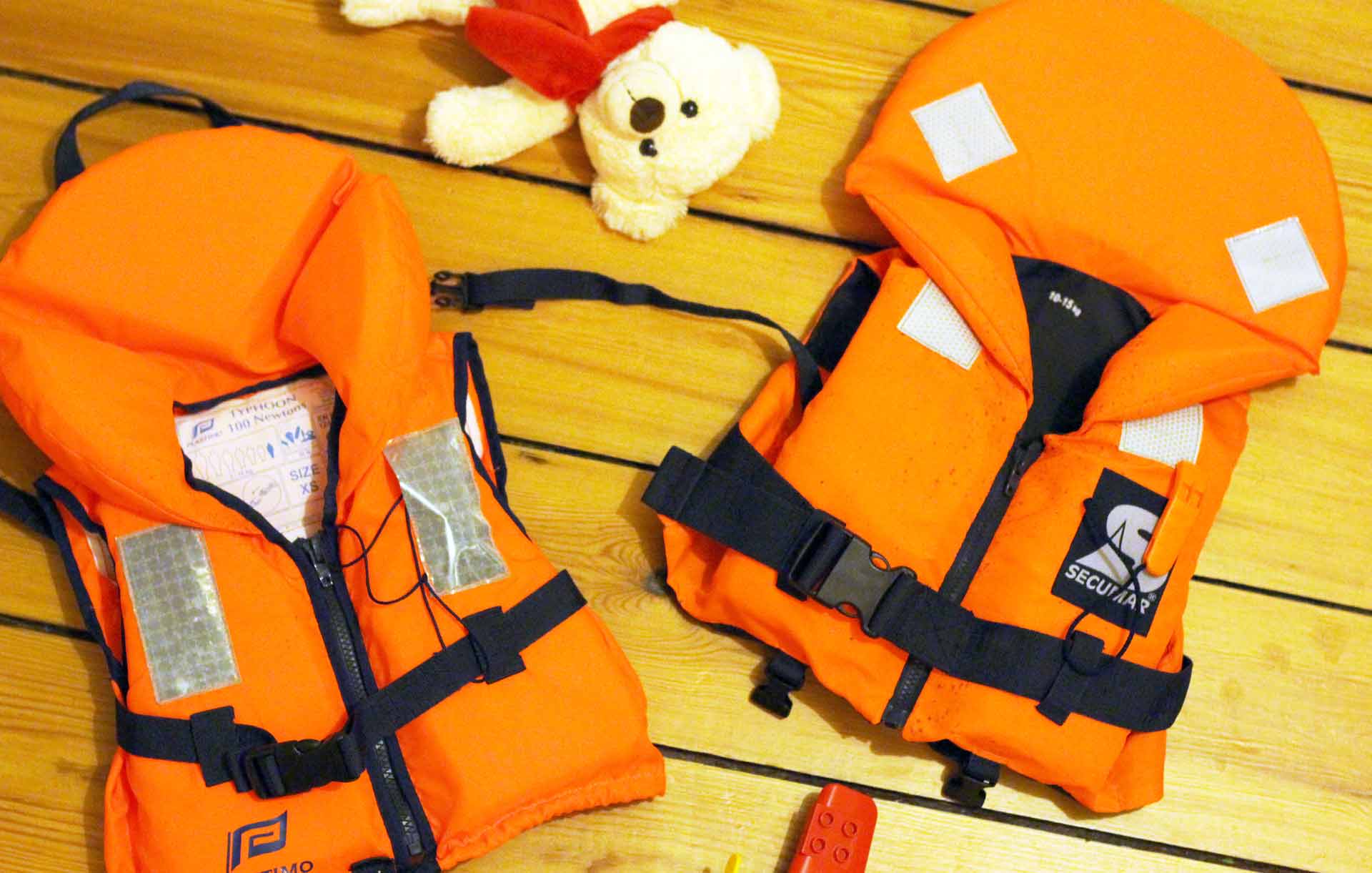It was more than a story told by someone who knows somebody who has experienced something. This one was real. I witnessed it. An infant, no 2 years old, falling into the water. At first it seemed all right because he was wearing a life vest. No problem. But then, shock, the little boy was floating on the water – upside down! His face under water, the vest didn´t pull him over. Acting in seconds the boy has been rescued, gasping to breath fresh air, no water in his lungs. Lucky he was. But the shock ran deep. That incident inspired me – being a father myself as well – to seek for professional advice on that topic since sailing with children is one of the reasons why I´ve decided to quit bike racing and get a boat for my family. I was lucky to find Doctor Georg Hillebrand who was willing to take some of his precious time to answer all my questions on child-safety onboard sailing yachts.
“After his first capsizing my son lost his trust in the boat.”
I meet Doctor Hillebrand in his bureau at the Itzehoe Medical Center not far from Hamburg where he is Head Physician of the Pediatric Hospital.
Lars Reisberg | NO FRILLS SAILING.com: Dr. Hillebrand. At first thanks for taking time for this interview. I hope not one of your little patients has to wait for treatment …
Dr. Hillebrand: No, no of course. It´s a tight schedule but there is nobody suffering while we talk. (he laughs)

NFS.com: I´ve been very lucky having found your name since you do not just bring an immense amount of specialist´s knowledge of the children´s body peculiarities but as I had learned you are a passionate sailor as well?
Dr. Hillebrand: Yes, that´s right. I am sailing since the age of 9, which count to some 37 years of sailing experience up to this date. I started with a 420 dinghy on a lake, later at the age of 19 I moved to Kiel and spent quite some time racing, mainly in the Contender – class. We toured the whole Baltic Sea and went from event to event virtually every weekend. Later on, I got more settled, started a family and we got our first cruising boat – a Folkboat. A very nice boat with which we undertook memorable cruises. I then changed back to dinghy sailing, on to a UK-built RS Vision. I liked this boat, we sailed it on the River Elbe and also took it up to Sweden in summer. Later on, it was more charter-sailing with 30, 34-feet yachts and finally, in the last years, I am trying out multihulls, first a French build Astus, now upgraded to a small nice Dragonfly trimaran.
NFS.com: So you too have been sailing with your children right from the start, haven´t you?
Dr. Hillebrand: We took them with us pretty early, yes that is right. My younger son is a passionate sailor by himself and he loves boats and all maritime stuff. Right now he is pretty busy in sailing Optimist-Class.
NFS.com: Which brings me to the topic of my interview: Did you have emergency situations with your son whilst sailing? What has been your experiences and how did it affect your son?
Dr. Hillebrand: As you might know, being on a dinghy is not the soundest mode of sailing. These small vessels are very agile and respond quickly to changing wind-situations. We once had such a situation where a sudden gust resulted in a capsize. Fortunately it wasn´t a very windy day and we´ve had not too much of high waves so it wasn´t a problem really. I grabbed my son with one hand, the boat with another, righted the boat and hauled him back onboard. He was 4 years old at that time, wearing proper neoprene suit and lifevest, everything went well – but this incident – although we have talked about the topic before – made an impact on him. He lost his trust in the boat for some months and it was a slow process for him to gain confidence again.
NFS.com: You re-worked the incident later with him?
Dr. Hillebrand: Yes, of course. Parents should always talk to their sailing children. They should explain things, why the boat behaves like this, why the wind does things like that. Kids are clever. They will understand. Parents shouldn´t over-protect their children or try to save them from everything: They can´t anyway. A better way is to teach their kids how to behave accordingly onboard and train to move safely.
“Drowning is a quiet death.”
NFS.com: Let me start with a basic question: How does drowning work?
Dr. Hillebrand: Well. It´s frighteningly easy. And quiet. It´s not like you may see in Hollywood-blockbusters with drowning people waiving wild with their arms or screaming the hell out of their lungs. Drowning is a quick process. Young children in their first years, before they know how to swim, can not hold themselves on the surface for more than a few seconds, they drown very quickly. At first, when water contacts the inner mouth and pharynx, the opening of the respiratory system, the glottis, is closed reflexively.
NFS.com: The airway shuts tight.
Dr. Hillebrand: Exactly. In the Larynx, two flaps will close and secure the lungs and the whole system from penetrating water. This glottic reflex happens automatically and saves us from drowning for the first seconds.
NFS.com: Seconds?
Dr. Hillebrand: Yes, only a few seconds. You see, because our body-functions do continue to work while we are under water we do need oxygen. And our brain, the bowels and muscles need much of it, so it is absolutely certain that at some point we will breathe again. There´s no way to prevent our body from breathing. Divers can train to hold their breath for a long, very long time, but we as normal persons are not trained. A child least of all. So, after 10 to 15 seconds the first long, deep breath will take place – and with it, when under water, the person will inhale water. We are no fish. We cannot extract oxygen from water, so the oxygen deficiency will sustain and so will our body try to grasp for air. And will inhale more and more water. Unconsciousness will set in a very short notice. That´s it.

NFS.com: How long?
Dr. Hillebrand: Well, it depends. Many factors here, I will tell you later more on that, but more important than that is the fact that the anoxia – the lack of oxygen – will cause irreversible brain damage: After some 5 minutes. So you should keep in mind those two figures: 10 to 15 seconds for the glottic closure reflex and maximum 5 minutes hypoxia until brain damage is not reversible.
NFS.com: Heavy stuff though …
Dr. Hillebrand: Oh, you bet that. But I can tell you that there are a lot of factors making these figures vary. We do know of drowned children that have been successfully reanimated after 45 minutes under water! Think of that long time! That´s because the lower the temperatures are the longer you have a chance for successful reanimation. So, astonishingly, drowning in cold water could save your life. The reason for that is, it evokes a body response called the “dive reflex”: Heart rate and metabolism are slowed down significantly, reducing the need for oxygen. Especially with children a very rapid and strong dive reflex can occur.
“Techniques of Basic Life Support should be a no-brainer for skipper-parents.”
NFS.com: And what then, what after we managed to get the child back on board or on dry land: Are the reanimation measures any different from that stuff we learned back then when we were taking our classes for driver´s license?
Dr. Hillebrand: Yes and no. There are similarities, some things are special. It´s called Basic Life Support or BLS and should be understood by every person whatsoever, especially by sailing parents. You can easily memorize the basic steps like this: A-B-C. “A” is the “Airway” and “B” stands for “Breathing”. “C” stands for “Circulation”. Concerning a child I would provide basic life support as following …
NFS.com: Oh, you have brought a little patient with you.
Dr. Hillebrand: Yes, that’s a manikin for training. It´s stuffed with electronics, it can talk, breathe and choke. We can simulate heartbeat as well. Even his lips will turn blue eventually. So back to our BLS for a drowned child: You first have to provide a clean airway. Turn the child´s head to the side and wipe out water or the vomit. You won´t hang the child heads-down or something, just lay it on it´s back, turn the head and wipe out the stuff.

NFS.com: That was the “A”.
Dr. Hillebrand: Right. Then you take the head and tilt it slightly backwards. Not too much – when reanimating an adult you will tilt the head much more but not with an infant, otherwise the tongue will close the airway. Then lift the chin with one finger, to close the child´s mouth. Now place your mouth over the child´s mouth and nose …
NFS.com: … and nose?
Dr. Hillebrand: Exactly, mouth AND nose. And insert air. Strong, one second lasting pushes of breath. Five times. Five strong pushes of air, each one lasting at least one second. You see, the child´s thorax has to move up and down significantly, then it´s done right. Mostly, when not too long in the water, the child´s breathing will return after that. If not you might begin with cardiac massage …
NFS.com: … we all know from driver´s license classes …
Dr. Hillebrand: Well, yes and no because it´s also a bit different with children. You will take two fingers and push. 15 pushes. Don´t be shy. You cannot break anything. 15 pushes let´s say at least 1.5 centimeters up and down of the thorax. 15 times. First responders say you might hit a frequency of 100 to 120 pushes per minute which is of course a bit abstract …
NFS.com: … it is indeed …
“Highway to hell. Or better: Stayin´ alive.”
Dr. Hillebrand: You might think of AC/DC´s “Highway to hell” which has exactly the right beats per minute. Or better take “Stayin´ alive” which has a more positive message. But no joke: 15 times in that particular stroke. We say: Push hard and fast! After that again 2 times pushing air into the body and then you keep on doing this until professional responders arrive at the scene.
NFS.com: For how long does BLS make sense?
Dr. Hillebrand: It makes sense to act according to BLS-techniques for a long, long time. Here is another saying of first responders here: “No one drowned is dead until he is warm and dead”. That means in addition to BLS you should take off all the wet, cold clothing and provide for warm cover. A blanket or other warm stuff. Go on with cardiac massage and breathing support. Remember: 45 minutes!

NFS.com: So I recount: Free the airways, stroke breath into the lungs and push hard fast. Pull off all wet clothing and keep the drowned warm under a blanket …
Dr. Hillebrand: Yes, try to prevent ongoing temperature loss. You do not have to aim for a fast return to 36 degrees Celsius normal temperature, in fact, the proper and final rewarming should be done slowly and controlled, preferably in a hospital setting. But keep the child as warm as possible and continue to reanimate the body until professional help arrives. Don´t pause. Keep on to switch between cardiac massage and ventilation in 15:2 relation.
“First of all: Onboard safety measures are clear mutual agreements.”
NFS.com: That´s truly a lot to know. A lot of responsibility though …
Dr. Hillebrand: Well, as the skipper you are the man in charge. And as a parent it´s double the responsibility, that´s true. But here´s a hint: Don´t panic. Although there are occurring such tragic incidents from time to time, yachting with children is relatively safe if you can manage to create a mutual understanding for rules onboard to prevent disaster.
NFS.com: Rule such as …
Dr. Hillebrand: Well, first of all I think it´s crucial not to scare the children. Sailing is fun and children should see the fun part above all. I think adults should focus much, much more on a self-reliant child. A child who is able to distinguish between safe and unsafe. You can train children to be competent sailors as well – and that won´t work with over-done safety measures and fear of death.

NFS.com: How did you train your children then?
Dr. Hillebrand: Well, one thing was to explain them when it was safe to go to the forward part of the deck and when they would have to stay inside the cockpit or even down in the cabin. They quickly understand by themselves and will behave accordingly. Wearing a life vest was customary and like all children onboard the adults wore one as well. There should be a natural given trust in the intellect of your child. I am convinced that too much prohibitions will only stimulate dislike of sailing or worse, fear. And that is what a skipper doesn´t want to have: Small passengers who hate sailing.
NFS.com: The problem of the so called “Helicopter-Parents” …
Dr. Hillebrand: Yes, you may call it like this. But, again, that´s a decision you as parents have to take by yourselves. Children are different. So is their upbringing. But concerning sailing, I would recommend to bring them onboard as early as possible and to adjust your sailing to it. It´s not just you who is in the middle of the story, you should bear in mind that activities we love might be boring for small children. Such as hours of hours of beating upwind. It´s just boring for them.
NFS.com: Limiting the sailing hours …
Dr. Hillebrand: Yeah. Four hours a day will be enough. Toddlers want to run, want to climb on things and be free. A yacht is very limited in that matter. Try to sail overnight when you want to go for a long leg, try to commit yourself to the fact that children have special demands. All that together is a safety measure as well.
“Life vests for children? Always on!”
NFS.com: Let´s come back to life vests again and go a bit into details here. Which product or type of vest would you recommend as an experienced sailing parent and physician?
Dr. Hillebrand: Well, at first – always go for an inherently buoyant / solid life jacket. I would strongly advise not to choose an inflatable one because these mechanisms do occasionally fail. With adults that´s no problem because they will pull the trigger by hand and inflate the jacket, but again, you cannot expect an infant to do so – especially in a dangerous, shocking and frightening situation such as going overboard. A second point is that you cannot know for sure if there won´t be anything restraining the jacket such as hood or anything from the infant´s clothing. So a solid life vest is the one of choice for small children.
NFS.com: Any labels to look for here?
Dr. Hillebrand: Well, at first go for the ISO-norm. You may check the internet for the one that is good for your infant. I remember ISO 12402-3, which is level 150N. That´s a good one for infants. Another good label would be the United States Coast Guard (USCG) Approval of a vest to look for. And remember that there are certain types of lifejackets, so a Type 1 PFD would be for offshore use, a Type 2 shore-sailing and the Type 3 is the minimum, a floatation aid. Not recommendable. Go for 1 or 2 and minimum would be 150N. The website lifejacketadvisor.com provides a load of information on lifejackets in this regard. A professional yacht shop can give further guidance which product may suit best for your children.
NFS.com: … and then: Don´t forget to put them on.

Dr. Hillebrand: No, really, don´t forget to! And besides: Put them on correctly because if improperly attached the vest can be very dangerous. You see, children do not have very long arms or strong armpits as adults have. So I must admit that I do see often infants with a lifejacket on – but the crotch strap isn´t applied correctly. The result in an MOB would be that the vest would create lift but the body will slip down inside the vest. The child is unable to move because it simply can´t anymore, the vest is like a huge shackle. Spray and water from the waves will break over the head and can cause very severe situations.
“My recommendations for sailing parents? An appeal to common sense.”
NFS.com: So what would be your general recommendations for sailing parents from a safety standpoint?
Dr. Hillebrand: From my point of view it begins with the kind of boat you go for. You should choose a boat with a deep cockpit with a high freeboard. That creates a safe space – although outside and near the water – but a deep cockpit is a huge plus in this regard. As I said earlier, mutual agreements when to leave it and when having to stay inside should be compulsory. Children should get their safe place on deck where they can sit down and can have a complete overview on the scene as well. They want to participate – they have to if you want them to learn something.
NFS.com: What about lifelines and tethers?
Dr. Hillebrand: To be honest, when the kids were young, I never sailed in conditions where lifelines in the cockpit were mandatory… You should use them in very heavy conditions, but then making them stay in the cabin may be the better option. My experience is that kids simply just don´t climb overboard and jump into the water. They are not stupid. Besides, tethers can be dangerous when the yacht is going at a faster rate of speed. I told them to climb to the windward-side of the cockpit, they quickly learned how to behave when the boat was heeling and there was never a dangerous situation I could remember and of course not any kind of horror scenarios and stupid suicidal Harakiri-moments some parents might fear. Again: Kids are very smart. A good idea though is to buy them a wetsuit. Warmth is crucial and indeed, when something bad happens it´s good to stay warm. It´s also good to stay warm in case nothing happens of course. Another point is the guardrail …
NFS.com: We´ve even had a tight net spanned all around the boat when we took our yacht from the Schlei to Hamburg (full article here).
Dr. Hillebrand: I do see nets like this very often. Again, it´s your decision and it depends on the type of boat. Be aware that they might create an illusion of safety. Because a guardrail won´t safe your child when a strong wave will hit the boat. The net might break. It can create a false prospect of safety. Again, I am an advocate for self-reliant children capable of understanding and accessing situations and able to behave accordingly. Believe me, kids will learn even if they are very young.
“In a calm minute: Train MOB with your children.”
NFS.com: I did learn so much from our conversation today, Dr. Hillebrand, I can only hope to keep all that stuff in mind. Would you recommend to attend a class for example to refresh my knowledge and skills in first aid?
Dr. Hillebrand: Well, no and yes. It´s never a bad idea to improve one´s skills, especially when it comes to the first responder´s. But to be honest, I think for example training with your kids is a more fruitful approach. You will improve your skills and at the same time your children can train how to behave in certain situations as well.
NFS.com: What do you mean by that?
Dr. Hillebrand: I do mean – grab them and thrown them in the water. Yes, in a calm moment, when there is summer, it´s warm and nice, don´t just take a bath and go for a swim but practice MOB. I did it with my children as well. It´s very interesting to watch them, to give them advice. They will learn how it feels like to swim with a lifejacket. They can test it´s buoyancy, can gain trust in the device. You should train with them how to come back on board by climbing up the bathing ladder. It´s fun and so useful too.

NFS.com: Yeah, I see your point. I did train Man-over-board by myself on the Hanseboot-fair as well, it was a very educating thing (full article here). Anything else?
Dr. Hillebrand: You know what? We have talked so much about Man over Board with children, first aid and drowning, cardiac massage and stuff – which is a very important topic of course – but there is one thing I would give to you to take it with you besides that. A thing much more common in sailing with children and more widespread: Sunburn. No really, that´s a huge thing. As well as wearing a lifejacket should be compulsory, applying sunscreen should be of same importance.
NFS.com: All right. Dr. Hillebrand. Thank you so much for answering all my questions. I must admit that´s a topic that is really hard to talk about for a father like myself because thinking of my children and what can happen to them just breaks my heart. Even seeing this manikin is hard to dare. But in the same time I do have hope that if done properly, wise and with a healthy sense of proportion, sailing with my kids can and will be what I am dreaming of all the time: Adventurous, education and simply the memory of a lifetime. Thank you so much for this interview.
Richard Jeske, experienced skipper and founder of my sailing school Well-Sailing is talking on sailing with kids as well – you may read the article on “What makes a good skipper” here.
